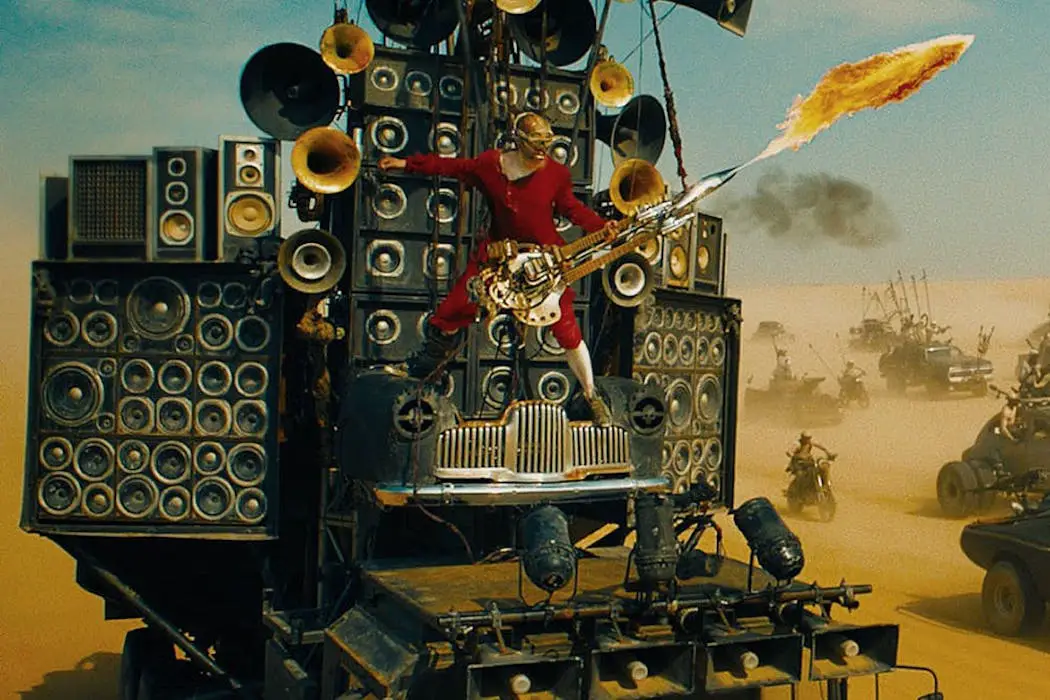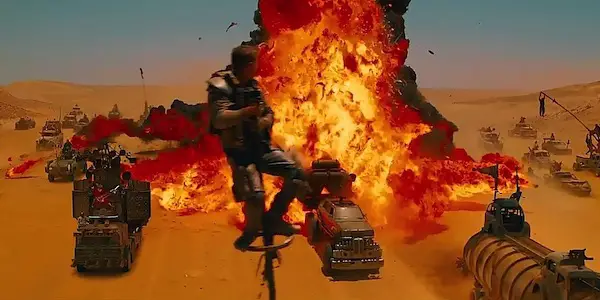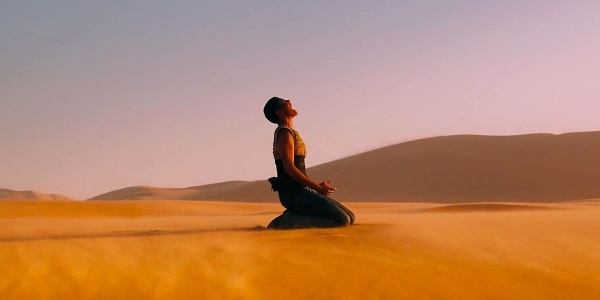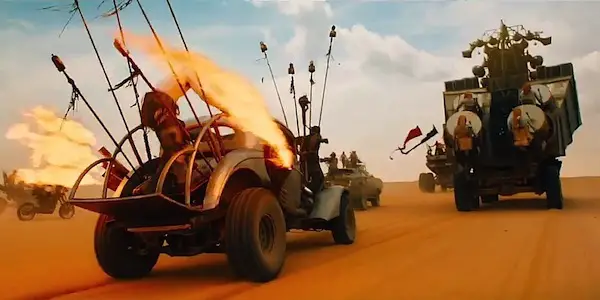The Difference Between Sound Editing And Mixing

Film critic, Ithaca College and University of St Andrews graduate,…
Sound design, despite being one of the most important elements of filmmaking, is one of the most misunderstood. Historically, the Oscars have awarded two trophies for sound — one for editing and another for mixing — though most casual viewers aren’t able to tell the difference between them.
For the 93rd Academy Awards, the show has combined the two categories into Best Sound. But that doesn’t magic away the tremendous work that goes into creating a film’s soundscape. A tentpole production (such as Avengers: Endgame) employs upwards of 80 or 90 boom operators, foley artists, ADR recordists, librarians, engineers, and mixers, and in recent years, no big-budget action spectacle has created a more inventive, vivacious, or iconic soundscape as Mad Max: Fury Road.
George Miller’s 2015 post-apocalyptic car chase epic won both sound Oscars in its year. Beneath the roar of those engines, the pulse of the Junkie XL score, and the hailstorm of bullets, there’s a masterclass in sound editing and mixing that illustrates how a movie’s sonic environment is assembled.
Sound Editing
Sound editing comprises the recording of all sound and sound effects, besides the score. For fantasy and sci-fi projects, such as Star Wars or Jurassic Park, foley crews work overtime to invent new sounds for their universes. R2-D2’s voice came from keys Ben Burtt hit on a synthesizer. Darth Vader’s deep, mechanical breathing is a diver’s mask. The T-rex’s scream combines a baby elephant shriek with crocodile and lion noises. (Both films swept the sound categories in their years.)
The category used to be called Best Sound Effects, then Best Sound Effects Editing, and it traditionally celebrates big-budget genre films. But even for smaller productions, sound crews have to get creative. Sometimes, librarians will find archival sounds or borrow from other sources (which is how the Wilhelm Scream began life as a stock death cry).

In nearly every film, you can guarantee that the wind, the rain, even the sound of a character’s footsteps, was not recorded during principal photography. They’re found later by sound recordists and engineers and patched into the existing cut. The goal of a sound team is to convince the viewer that the sound and image are a whole rather than separate elements.
One of my film school professors edits sound for Ken Burns’ documentary series. She described how, for a segment focusing on the Triangle Shirtwaist Factory fire, they needed an audio cue for the women who were forced to jump from the high windows. She and her sound crew found a two-story shop corner, threw a dress on a pig carcass, and spent the day throwing the pig out the window and recording the dress flap as it fell.
In Fury Road, Miller’s team developed sonic personalities for each new vehicle. The porcupine-like raider cars have bee swarm sounds underneath their engines, while the War Rig that Imperator Furiosa (Charlize Theron) drives is built from whale noises. When Nux (Nicholas Hoult) T-bones the War Rig in the canyon, we see a slow-motion shot of the gargantuan truck crashing: “All those sounds, there are no realistic sounds there,” sound designer Mark Mangini told The Frame. “Those are all whale sounds and actually slowed-down bear sounds.” Because Fury Road’s cars, trucks, and motorcycles are so alien to us, every vehicle is like a new species of animal, with unique noises for when it’s idle, accelerating, braking, creaking, or exploding, and it seems to be a rule for Fury Road that no two vehicles explode the same way.
Sound Mixing
If sound editing encompasses the creation of sound effects, then sound mixing is how all those elements are assembled into the final film. Fury Road opens with a madhouse cacophony of noise, where Max (Tom Hardy) is kidnapped, tattooed, and branded by an army of War Boys. The background noise comprises engine sounds and metal clanking. When Max escapes, he doesn’t just run through some tunnels, bare feet on dirt. He sloshes through water, his chains rattle, and the whole time, the War Boys clamor and screech and throw their bodies in pursuit. The sound mixing team has to make sense of the individual sounds and make a cohesive scene.
Fury Road has very few moments of silence. Even Furiosa’s ominous drive through the canyon has engine ambiance, Junkie XL’s heartbeat soundtrack, and the far-off sounds of wind. But the film needs these quieter moments, without which the frenetic action sequences won’t pop. Overseeing the mix is Mangini, the supervising sound editor, who’s basically “the sound equivalent of a director of photography,” as he told Deadline. In those action sequences, with dozens of cars, a hundred shouting War Boys and hundreds more moving parts, the mix team had reportedly 2,000 audio channels to work with — you can imagine one channel for every car, explosion, gunshot, scream, punch, or music swell.

You can pick out the sound mixer’s work the most with Fury Road’s attention to its dialogue. Amid the tumult of insane vehicular combat, Max’s grunts are still audible, Furiosa’s shouted instructions still distinct. In the more artistic moments, like Max’s frequent hallucinations of a little girl (Coco Jack Gillies), the voices pop too. Gillies’ whispers are sharp, eerie, and ghoulish. Mangini plays with distance and the open desert a lot as well, as when the Bullet Farmer (Richard Carter)’s voice bellows over the mudflats, or when you see the war party in an extreme long shot and can recognize the frenzied War Boy cries and the death beat of the Doof Wagon.
The sound mixers are also responsible for sonic themes. Per our own Joseph Klingman, who wrote about the use of sound in Fury Road: “The film accents the world with auditory hints of sickness. Max’s wince-worthy tattoo job early in the film lends the sound-suggestion of moist, bloodied flesh; and horrid, wheezed breathing racked with a mucous cough makes up our first introduction to Immortan Joe.”
Conclusion: Combining Categories
Editing and mixing are different enough that the same film shouldn’t win both awards. Yet, in 12 of the past 23 Oscars ceremonies, the Academy presented the same film with both sound trophies. That track record doesn’t help casual viewers discern between two already-technical categories, and this probably contributed to the sound branch’s decision to combine them for the 93rd Academy Awards. (Also a benefit to the Academy — combining the fields lets the ceremony run shorter, and reducing the number of technical achievement Oscars throws a bone to the viewers just tuning in to see which celebrities win.)
It’s upsetting to see the Academy Awards neglecting the work of technicians and craftspeople in favor of a more streamlined ceremony. The sound categories were never perfect — documentaries and animated films, for example, which similarly have to construct soundscapes from scratch, never got their due. And we don’t pay enough attention to the quiet — think of how much weight a creaking floorboard has in Portrait of a Lady on Fire, or how subtle sounds of a house settling lend so much more tension to 2020’s Invisible Man remake. War films, epics, and sci-fi tend to choke out the competition.

Of course, the art these sound designers made will stand the test of time regardless of their awards recognition. Fury Road will doubtlessly be examined by future sound technicians the same way sound crews marvel at what Ben Burtt achieved with the original Star Wars films. Great sound design — editing and mixing — is about storytelling, and that’s one thing that never changes.
What do you think about the new Best Sound category? Let us know in the comments below.
Does content like this matter to you?
Become a Member and support film journalism. Unlock access to all of Film Inquiry`s great articles. Join a community of like-minded readers who are passionate about cinema - get access to our private members Network, give back to independent filmmakers, and more.
Film critic, Ithaca College and University of St Andrews graduate, head of the "Paddington 2" fan club.













